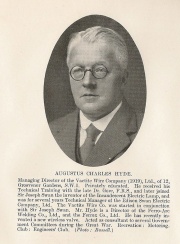Augustus Charles Hyde

Augustus Charles Hyde (1870-1935)
1870 Born in Durham the son of Adam Hyde, Iron Master. Brother of George Herbert MacCarthy Hyde
c.1881 his father died when he was 11 years old so, along with his older brother, was sent to the Crossley and Porter school in Halifax, where he completed his education, leaving the school aged 15 years.
He was trained in Birmingham by George Gore and apprenticed to Sir Joseph Swan.
He was an analytical chemist and during his early career he worked closely with Captain Mullard of Mullard Lamps.
A. C. Hyde also worked with Sir Arthur Du Cros.
A. C. Hyde started various companies;
- Nox Electric Lamp Co Ltd., (later sold).
- Formed Vactite Wire Co Ltd in 1919, Acton, London (later sold to London Electric Wire Co)
- Formed Ferro-Arc Welding Co Ltd (later sold to British Oxygen Co)
- Formed Ferrox Co Ltd
He was a prolific patentee in the late 19th and early 20th centuries. He described himself as an "Electrochemist" in his patents, and most of his patents were directed to means of impregnating or coating one metal with another, and joining metals by soldering or welding. His interest in light bulbs appears to have grown out of this, as most of his light bulb patents are directed to methods of treating the filaments by novel metal coating or impregnating methods.
Hyde's patents related to light bulbs were:
- GB24918/04 "Improvements in the Manufacture of Leading-in Conductors for Incandescent Electric Lamps, or other Vessels requiring Gas-tight Joints", applied for 17th November 1904, accepted 16th December 1905. Manufacture of lamp wires from nickeliron alloy wire, coated with molten silver-platinum alloy under a hydrogen atmosphere.
- GB6487/12 "Improvements in Electric Incandescent Lamps", applied for 15th March 1912, accepted 8th August 1912. Describes light bulbs in which the filament is mounted on elastic supports which do not carry any of the electric current. The description and claims of this patent were slightly amended at a later date. Both the original and amended patent are in the British Library collection.
- GB10472/06 "Improvements in the Manufacture of Leading-in Conductors for Incandescent Electric Lamps and Analogous Glass Vessels", applied for 4th May 1906, accepted 24th January 1907. Manufacture of lamp wires from nickel-iron alloy wire, coated with bands of silver-platinum alloy at the points where the wires are to be embedded in the glass.
- GB4159/11 "Improvements in and relating to the Preparation of Ductile Molybdenum and Articles Made therefrom", applied for 18th February 1911, accepted 25th May 1911. Describes the manufacture of molybdenum wire for light bulb filaments by heating a paste of molybdenum powder with a binder to high temperature under an inert or reducing atmosphere.
- GB6487/12 "Improvements in Electric Incandescent Lamps", applied for 15th March 1912, accepted 8th August 1912. Describes light bulbs in which the filament is mounted on elastic supports which do not carry any of the electric current. The description and claims of this patent were slightly amended at a later date. Both the original and amended patent are in the British Library collection.
- GB10472/06 "Improvements in the Manufacture of Leading-in Conductors for Incandescent Electric Lamps and Analogous Glass Vessels", applied for 4th May 1906, accepted 24th January 1907. Manufacture of lamp wires from nickel-iron alloy wire, coated with bands of silver-platinum alloy at the points where the wires are to be embedded in the glass.
- GB4159/11 "Improvements in and relating to the Preparation of Ductile Molybdenum and Articles Made therefrom", applied for 18th February 1911, accepted 25th May 1911. Describes the manufacture of molybdenum wire for light bulb filaments by heating a paste of molybdenum powder with a binder to high temperature under an inert or reducing atmosphere.
- GB240213 "Improvements in Thermionic Valves", applied for 20th June 1924, accepted 21st September 1925. Manufacture of filaments to be used as cathodes in thermionic valves from tungsten wire, coated with thorium or uranium by coating the wire with thorium or uranium powder mixed with tungstic acid or a platinum salt solution, followed by heating under an inert or reducing atmosphere.

